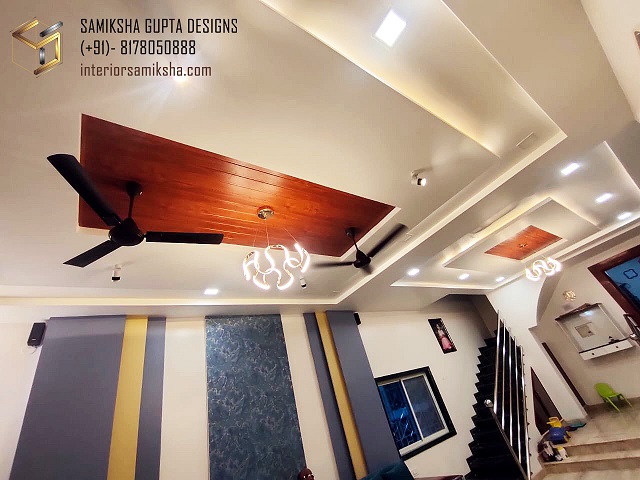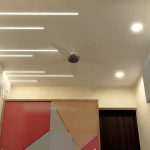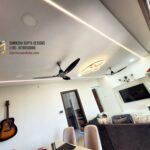The last decade has seen a major evolution in the false ceiling trends. When I started off my career as an interior designer in Delhi, I only knew of the POP false ceiling. And later on, I was introduced to many other false ceiling materials. I came across gypsum, which was basically sheets of POP (plaster of Paris) and was more cost-effective than actual POP. The reason is, easy installation and hence, cut down labour costs.
I also saw people using real wood or ply+ laminate on the ceiling to give a wooden texture. But since it was a bit heavy on the pocket, people came up with WPC and PVC panels for false ceiling or wall panelling installations. While these are pretty convenient to install, they are also quite cost-effective and I have been using these in my current projects a lot.
Here I used it in a bungalow renovation project.

The gypsum false ceiling was already done on the site. However, the client wanted to give a wooden look and feel without completely changing the false ceiling.
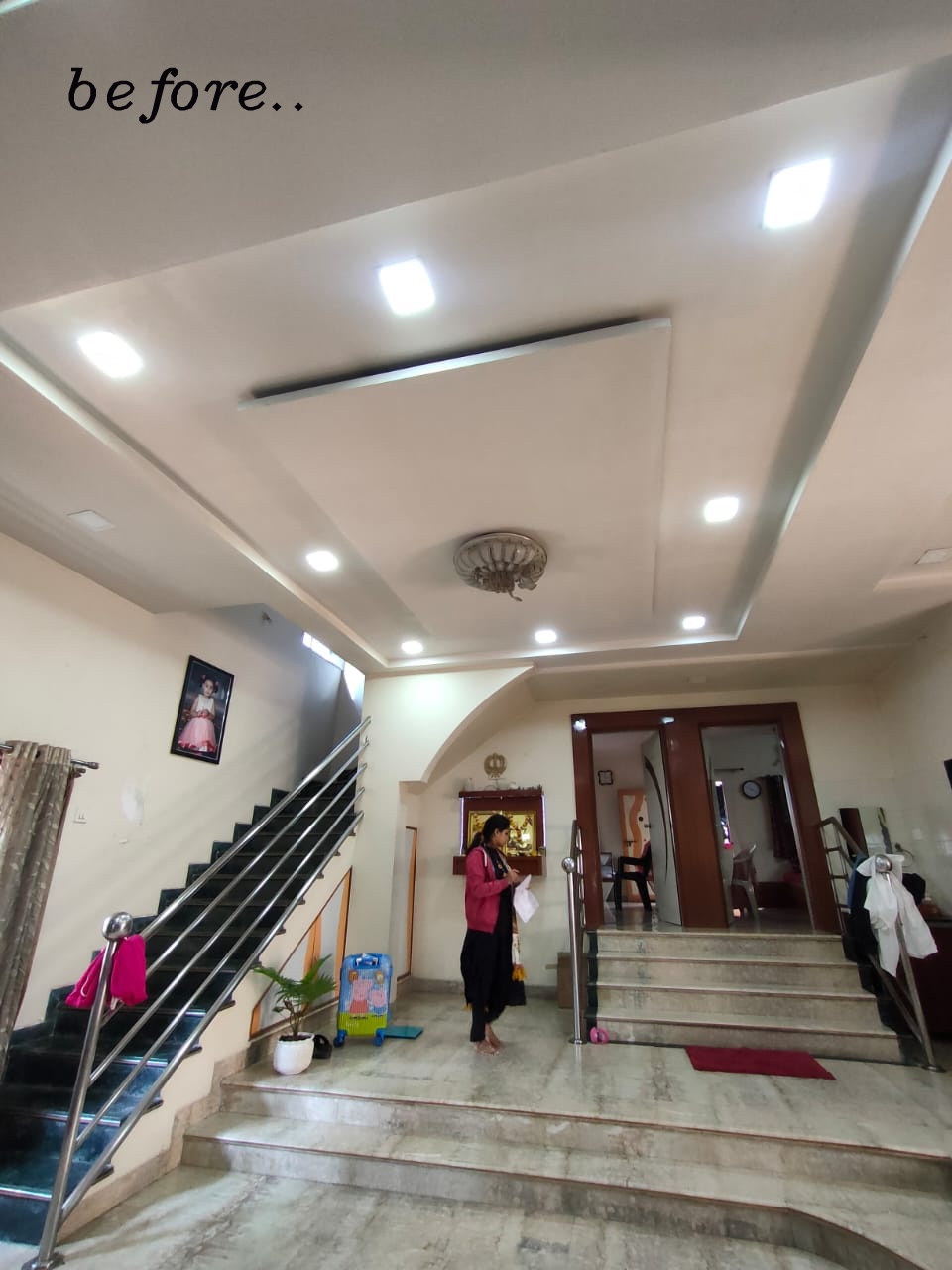
I did some modifications to the existing ceiling and the results were amazing!
Before I go on and tell you about the pros and cons of the PVC ceiling, let me give you a bit of a preview of the popular gypsum ceiling.
Gypsum False Ceiling
Some other common names for gypsum false ceilings are drywall ceilings or plasterboard ceilings. As I already mentioned, the base material of gypsum is the POP, i.e. Plaster of Paris, which is processed into boards and used to create suspended ceiling structures on aluminium channels.
Gypsum false ceiling is usually the first and preferred choice for residential and commercial buildings. And rightly so, with its several advantages. It gives a seamless and smooth finish and enhances the aesthetic appeal of the space. It’s also cut, shaped and moulded easily into various designs, allowing for more creativity and customization as ceiling solutions.
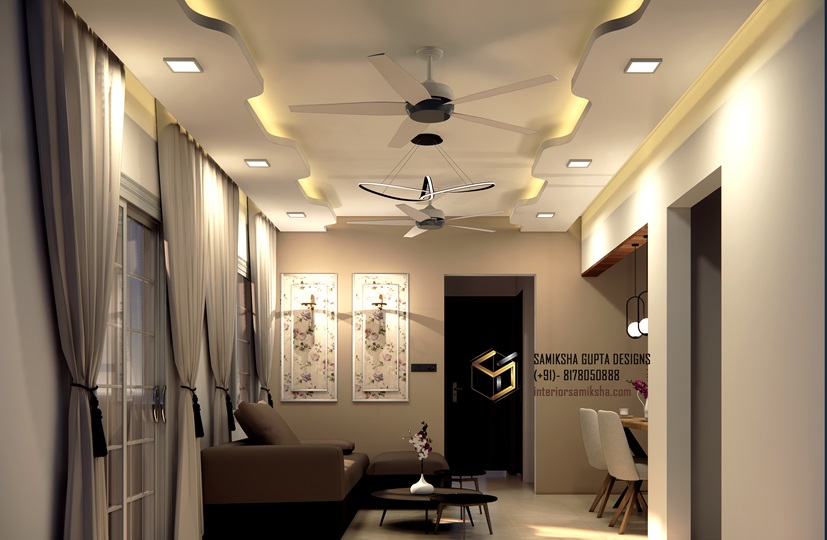
Benefits of Gypsum False Ceiling
- One of the primary advantages of gypsum false ceilings is its fire-resistant properties. This makes it a safer choice for buildings, as it can help contain the spread of fire and give more evacuation time.
- Gypsum false ceilings also provide acoustic insulation. It absorbs sound and reduces noise transmission between floors and rooms. Hence, it’s also a good choice for theatres, offices and educational institutions.
- Needless to say, it’s easy to install and lightweight, which makes its handling easier.
- It is more cost-effective than a lot of other ceiling materials. The price may, however, vary based on the thickness of the gypsum boards, labour charges location-wise, and design complexity.
Now that we’ve seen the properties of the Gypsum False Ceiling, let’s also have a look at PVC false ceilings and understand which type of false ceiling is suitable for all spaces.
PVC False Ceiling
PVC false ceilings, also called Poly Vinyl Chloride false ceilings, are made from a type of PVC plastic. It has its own advantages like durability, aesthetics, and ease of maintenance.
PVC ceilings have recently gained popularity because of its affordability and versatility.
These are panels that are installed below the main ceiling, or the true slab and create a suspended ceiling effect. These panels come in different sizes, colours and designs and hence give the designers a lot of design options.
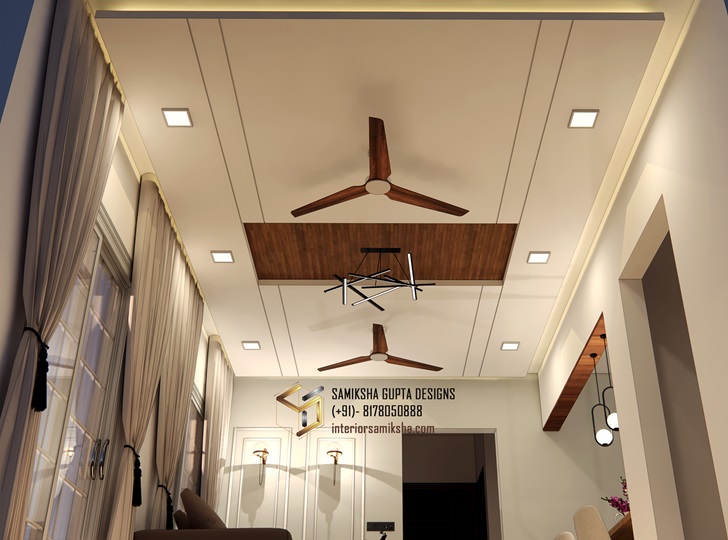
The panels are easily cut, shaped & installed to accommodate the light fixtures or AC vents.
Advantages of PVC False Ceiling
- I have already mentioned many advantages of PVC ceilings above. But one of the primary advantages is that of its aesthetic appeal. PVC ceilings provide a uniform and smooth surface that enhances the overall look of the space.

They come in different patterns, textures and decorative designs, allowing for visually appealing and creative ceiling options. You can also paint or laminate the PVC ceiling panels to achieve the desired colour scheme and create a stylish and cohesive interior.
- Durability is another advantage of PVC ceilings. PVC is a robust material. It is capable of resisting termite infestation, moisture, and fungal growth. Hence, it’s best for areas with high humidity, such as kitchens, bathrooms or even basements.
- Easy to clean and maintain. You just need to wipe it with a damp cloth and get rid of all the dust or stains on PVC panels.
- PVC false ceilings offer thermal insulation properties, aiding in maintaining a comfortable indoor temperature. They can reduce the heat transfer between different floors of a building, potentially contributing to energy efficiency and cost savings in terms of air conditioning or heating.
- Because of its lightweight nature, PVC ceilings are convenient to handle and easy to install. The panels are attached to the suspended metal framework from the main ceiling in an interlocked fashion. The easy and efficient installation method saves time and labour, making it cost-effective overall.
Conclusion
While selecting the right false ceiling material for your space, it is important to consider factors such as budget, desired looks, functionality, environmental conditions and maintenance requirements.
If you don’t know much about such technicalities, it’s best to consult a professional or an expert for the same. Hiring an experienced interior designer is an option too. They can also help you not only set up a budget but also with the various design options and can create 3D designs of the final look before you put things into execution.
Here’s how I visualized the space to look before we went up with our decision to use PVC panels in the false ceiling modifications.

With this, I will end this article. I hope it was helpful to you. If you like the information that I shared, please share the blog post with your family and friends and spread the word.
If you would like to add to this, or you have any suggestions, you can mention them in the comments below and I make sure that the information is shared.
Cheers!
Samiksha

